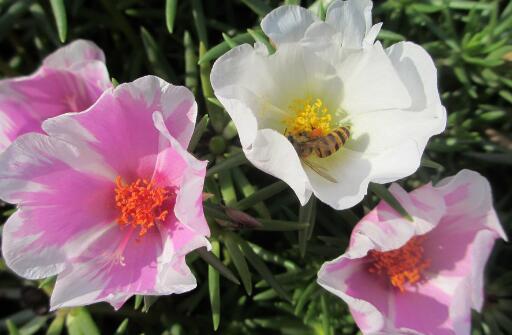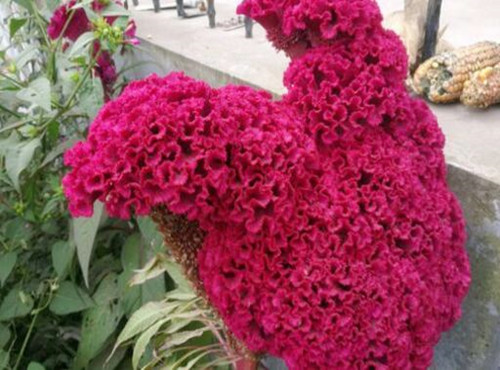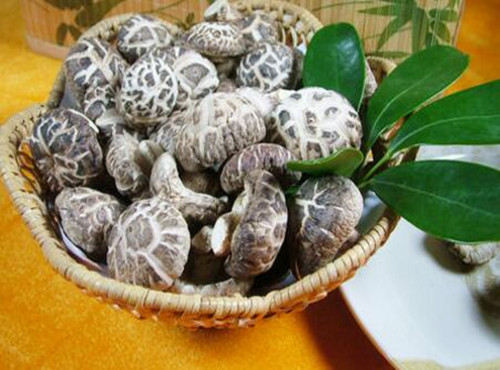What are the methods and points for attention of sunflower culture in Portulaca oleracea? When will it blossom? What's the moral?
Sunflower, also known as pine leaf peony, half lotus, Portulaca perennial flowers, often for annual cultivation. Like warm, sunny and dry environment, easy to raise and easy to survive. The flowers are of many colors and have light fragrance. What are the methods and matters needing attention in sunflower culture? When will it blossom? What's the moral?

The culture method of sunflower:
1. Soil: extremely resistant to barren, general soil can adapt, and sandy soil with good drainage is the most suitable, which can be made by mixing 3 parts of pastoral mature soil, 5 parts of yellow sand, 2 parts of rice chaff ash or fine sawdust, plus a little calcium superphosphate powder.
2.Illumination: sunflowers like to have plenty of sunshine. If sufficient sunshine can be ensured during the whole growth period, leaves and flowers will grow.
3. Temperature: sunflowers like warm climate, the germination temperature is 21: 24 ℃, about 7: 10 days, the seedlings are extremely weak, so if the temperature is kept high, the seedlings grow very fast and can form sturdy, fleshy branches and leaves.
4. Insect pests: there are few diseases and insect pests in sunflowers. As long as aphids, apricot wasps and apricot beetles are controlled, the key to control aphids is spraying before germination, that is, during the period of flower bud expansion. Imidacloprid 4000-5000 times solution can be used in this period. After germination, the solution of imidacloprid 4000 × 5000 and cypermethrin 2000 × 3000 can kill aphids as well as almond bees. 1500 times of aphid solution can be used after fruit setting.
5. Fertilization: sunflowers do not have high requirements for fertilizer. Applying 1/1000 potassium dihydrogen phosphate once a month can achieve the goal of large and colorful flowers and continuous blooming.
Culture methods of potted sunflowers:
1. Soil
Sunflower is not strict on soil, can grow in all kinds of soil, can be planted from fertile soil to barren soil, dry land and saline-alkali land, and has strong salt-alkali tolerance and drought resistance. The soil pH value is 5.8-6.5 for the best growth. The soil should be ploughed and loosened before sterilization and sowing to improve soil structure and drainage. Good soil permeability is very important for the growth of sunflowers.
2. Raising seedlings
Hole plates and nutrition bowls can be used to raise seedlings, and the seedling substrate can be proportioned with peat, vermiculite and sand according to 2:1:1, and a little organic fertilizer can be mixed at the same time. Potted sunflower seeds are small, the top soil capacity is relatively weak, sowing is not easy to be too deep, generally about 1 cm. Covering soil after sowing, light suppression, such as raising seedlings in winter and spring, can be covered with plastic film to keep warm and shorten the time of seedling emergence. Keep the soil moist after sowing, generally 3 to 5 days in summer and 5 to 10 days in winter and spring.
3. Transplanting
Transplanting as soon as possible can not only shorten the slow seedling time, but also prevent the emergence of "tall seedlings". The plant can be transplanted when it grows a pair of true leaves. After two weeks of sowing, sunflower seedlings can grow strong roots. The root system of sunflower seedlings is very strong, which is the basis to ensure a high survival rate of transplanting.
4. Watering
Because the root system is more developed, it is more resistant to drought. From sowing to budding, it is more resistant to drought, and proper drought is beneficial to root development. In the future, due to strong light, high temperature, tall plants, large leaves and large water consumption, the period from budding to flowering is the peak period of water demand and must be watered in time. If the potted soil is too dry, it will seriously affect the quality of flowering, especially the potted plants with small and large pots, which should be replenished in time, otherwise it is easy to dehydrate and wilt. But watering should not be too much, too wet basin soil will lead to leaves yellowing. Watering during the growth period should grasp the principle of "alternating between dry and wet".
5. Fertilization
Like fertilizer, fertilizer is applied every 7 to 10 days during the growth period. Nitrogen fertilizer should be used as the main fertilizer at seedling stage to promote the growth of branches and leaves, and potassium fertilizer should be applied after bud appearance to make flower buds develop well and facilitate flowering. When there is a lack of fertilizer, not only the branches and leaves grow thin, but also the leaves at the base of the plant are withered and yellow, resulting in the unbeautiful shape of the plant.
6. Temperature
Sunflower is native to the tropics, but it has strong adaptability to temperature. it is a kind of plant that likes temperature and is resistant to cold. Sunflower seeds have strong tolerance to low temperature, local temperature is stable, seeds begin to germinate when the temperature is more than 2 ℃, seeds can germinate and take root when the soil temperature reaches 4 ℃, and the needs of seed germination and emergence can be met when the ground temperature reaches 8 ℃. The optimum temperature for sunflower germination is 31-37 ℃. The optimum daytime temperature for its growth is 18: 30 ℃, and the night temperature is 10: 18 ℃. During the whole growth process, sunflowers can grow normally as long as the temperature is not lower than 10 ℃. In the suitable temperature range, the higher the temperature, the faster the development. Ventilation should be carried out to prevent the noon temperature above 25 ℃, and heat preservation should be carried out when the night temperature is below 13 ℃.
7. Lighting
Sunflowers are short-day crops. But it is not very sensitive to sunlight. Sunflowers like plenty of sunlight, and their seedlings, leaves and disk have strong phototropism. Sufficient sunshine at seedling stage and strong seedlings, and sufficient sunshine in middle growth stage can promote stem and leaf growth and flower bud differentiation.
8. Pollination
For cross-pollinated plants, artificial pollination during flowering can improve the seed setting rate. Double petal species are not easy to bear fruit, and artificial pollination is needed to improve the seed setting rate and harvest seeds. The best pollination time is 9: 11 a.m. and pollination for 2 or 3 times in a row.
9. Diseases and insect pests
The incidence of sunflower diseases and insect pests is low, the main diseases are bacterial leaf spot, rust, stem rot, powdery mildew and black spot; the main pests are aphids, blind bugs, red spiders and beetles.
Points for attention in sunflower culture:
① has plenty of light. Portulaca oleracea is a kind of strong positive plant, which needs plenty of sunshine during its growth and flowering period. no matter it is cultivated in open field or potted, it should be chosen in a sunny and sunny place. During the flowering period, if the weather is sunny, the climate must be dry and colorful, and the flowering condition changes with the sunshine, blossoms as soon as you see the sun, closes when there is not enough light sooner or later, and does not open on overcast and rainy days.
② drainage is better. Portulaca oleracea is extremely resistant to barren, the soil requirements are not strict, but the drainage must be good, open-field cultivation in low-lying areas. Pot soil should choose loose soil, otherwise stagnant water and long-term dampness will cause plant rot.
③ fertilizer and water management should be appropriate. As Portulaca oleracea has fleshy stems and leaves and is resistant to drought, it is better for the soil to be slightly dry, and it is generally appropriate to water the topsoil. During the growing period, liquid fertilizer should be applied for 2 or 3 times.
Sunflower sowing time
Generally speaking, seeds can be sowed in spring, summer and autumn, and in most cases they can be sown in spring. Jiangsu, Zhejiang and Shanghai can start sowing around mid-April, and flower friends in the south or north can adjust the time accordingly. Generally speaking, they can sow seeds when the average minimum temperature is about 18 ℃.
Sunflowers take about 50-60 days from sowing to flowering.
When do sunflowers blossom
Sunflower is annual fleshy grass flower. Plant height 12-15 cm, stem and round, prostrate ground, apex oblique extension, many branches, slightly colored, smooth. The flowers bloom continuously from June to September, and the flowers are solitary or clustered at the top of the branches. The flower stem is 3-4 cm. There are double and single. Because of its habit of seeing the sun blossom. Flowers are closed in the morning, evening and cloudy days, and the stronger the sun is, the better the flowers are, so they are known as sunflowers and noon flowers.
The moral of sunflower
The words of sunflowers: silent love, light, enthusiasm, loyalty, sunshine, positive.
Sunflower is a kind of flower that is easy to feed, as long as there is plenty of sunshine, it can bloom brightly.
Time: 2019-03-20 Click:
- Prev

"True Love Eternity" how much is the cockscomb seed per jin? How do you plant it? What are the effects and effects?
Celosia cristata is native to Africa, tropical America and India. It is widely cultivated all over the world and is an annual herb. It has high medicinal value and economic value. It is deeply loved by people because of its red and beautiful colors. So, how much is the cockscomb seed per jin? How do you plant it? What are the effects and effects? It is understood that
- Next

Where is the producing area of "Shanzhen" flower mushroom? How to plant it? How much is it per jin? What are the effects and effects?
Pleurotus ostreatus is the star of bacteria, and it is a kind of excellent mushroom produced by the fruiting body of Lentinus edodes in special environment. Its meat is thick, delicate, delicious and tastes refreshing. It is a rookie of edible fungus developed in modern times. So, where is the producing area of mushrooms? How to plant it? How much is it per jin? What are the effects and effects
Related
- Fuxing push coffee new agricultural production and marketing class: lack of small-scale processing plants
- Jujube rice field leisure farm deep ploughing Yilan for five years to create a space for organic food and play
- Nongyu Farm-A trial of organic papaya for brave women with advanced technology
- Four points for attention in the prevention and control of diseases and insect pests of edible fungi
- How to add nutrient solution to Edible Fungi
- Is there any good way to control edible fungus mites?
- Open Inoculation Technology of Edible Fungi
- Is there any clever way to use fertilizer for edible fungus in winter?
- What agents are used to kill the pathogens of edible fungi in the mushroom shed?
- Rapid drying of Edible Fungi

